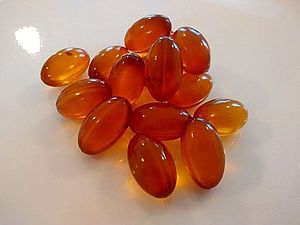ドコサヘキサエン酸
Docosahexaenoic acid/ja

| |||
| |||
| Names | |||
|---|---|---|---|
| Preferred IUPAC name
(4Z,7Z,10Z,13Z,16Z,19Z)-Docosa-4,7,10,13,16,19-hexaenoic acid | |||
| Other names | |||
| Identifiers | |||
3D model (JSmol)
|
|||
| Abbreviations | DHA | ||
| 1715505 | |||
| ChEBI | |||
| ChEMBL | |||
| ChemSpider | |||
| DrugBank | |||
| EC Number |
| ||
| KEGG | |||
PubChem CID
|
|||
| UNII | |||
| |||
| |||
| Properties | |||
| C22H32O2 | |||
| Molar mass | 328.488 g/mol | ||
| Density | 0.943 g/cm3 | ||
| Melting point | −44 °C (−47 °F; 229 K) | ||
| Boiling point | 446.7 °C (836.1 °F; 719.8 K) | ||
ドコサヘキサエン酸(DHA)は、ヒトの脳、大脳皮質、皮膚、網膜の主要な構造成分であるオメガ3脂肪酸である。22:6(n-3)という脂肪酸表記法が与えられている。DHAはα-リノレン酸から合成することもできるし、母乳(母乳)、脂肪分の多い魚、魚油、藻類油から直接摂取することもできる。DHA(例えば、サケ、ニシン、サバ、イワシなどの脂肪魚から)の摂取は、認知を含む多くの生理学的利益に寄与する。脳の神経細胞の主要な構造成分であるDHAの機能は、神経細胞の伝導をサポートし、神経細胞膜タンパク質(受容体や酵素など)の最適な機能を可能にすることである。
構造的には、DHAは22-炭素鎖(docosa-は古代ギリシア語の22に由来する)と6つ(hexa-)のcis二重結合(-en-)を持つカルボン酸(-oic acid)である。慣用名はcervonic acid(ラテン語で「脳」を意味するcerebrumに由来)であり、その系統名はall-cis-docosa-4,7,10,13,16,19-hexa-enoic acidである。
DHAを含む藻類やDHAを含む動物性食品を食べない生物では、DHAは代わりにα-リノレン酸から体内で生産され、 より短いオメガ3脂肪酸で、植物によって製造される(植物から得られる動物性食品にも含まれる)。 限られた量のエイコサペンタエン酸とドコサペンタエン酸は、若い女性と男性のα-リノレン酸代謝の可能な産物である。 母乳中のDHAは発育中の乳児にとって重要である。女性のDHA産生率は男性より15%高い。
DHAは脳のリン脂質や網膜に含まれる主要な脂肪酸である。予備研究では、アルツハイマー病や心血管疾患などの疾患における潜在的な有用性が調査されている。
中枢神経系成分
DHAは、脳と網膜に最も多く存在するオメガ3系脂肪酸である。DHAは脳の多価不飽和脂肪酸の40%、網膜のPUFAの60%を占める。神経細胞の細胞膜の50%はDHAで構成されている。DHAは、コリン、グリシン、タウリンのキャリアを介した輸送、遅延整流カリウムチャネルの機能、およびシナプス小胞に含まれるロドプシンの応答を調節する。
DHAを多く含むホスファチジルセリン(PS)は、神経細胞シグナル伝達や神経伝達物質の合成に関与しており、DHAの欠乏は認知機能の低下と関連している。重度のうつ病患者の脳組織では、DHA濃度が低下している。
生合成
好気性真核生物の経路
好気性真核生物、具体的には微細藻類、コケ、菌類、および一部の動物は、デサチュラーゼとエロンガーゼ酵素の連続的な作用によって触媒される一連の脱飽和反応と伸長反応としてDHAの生合成を行う。もともとThraustochytriumで同定されたこの経路は、これらのグループに当てはまる:
- デルタ6デサチュラーゼによってα-リノレン酸の6番目の炭素で脱飽和が起こり、ステアリドン酸(SDA、18:4 ω-3)が生成される、
- ステアリドン酸がデルタ6エロンガーゼによって伸長され、エイコサテトラエン酸(ETA、20:4 ω-3)が生成される、
- デルタ5デサチュラーゼによってエイコサテトラエン酸の5番目の炭素で脱飽和し、エイコサペンタエン酸(EPA、20:5 ω-3)を生成する、
- デルタ5エロンガーゼによってエイコサペンタエン酸が伸長され、ドコサペンタエン酸(DPA、22:5 ω-3)が生成される。
- デルタ4デサチュラーゼによってドコサペンタエン酸の4番目の炭素で脱飽和してDHAを生成する。
哺乳類
ヒトでは、DHAは食事から摂取するか、エイコサペンタエン酸(EPA、20:5、ω-3)から少量変換される。2015年にヒトのΔ4-脱飽和酵素としてFADS2が同定されたことで、ヒトもDPAへのΔ5-伸長とDHAへのΔ4-脱飽和を含む、「好気性真核生物」全体の経路をたどることが知られるようになった。
1991年に提唱された「Sprecherのシャント」仮説では、EPAは24:5 ω-3に2回伸長された後、ミトコンドリアで(Δ6デサチュラーゼを介して)24:6 ω-3に脱飽和され、その後ペルオキシソームでβ酸化を介してDHA(22:6 ω-3)に短縮されると仮定している。科学者たちは(2015年まで)長い間、哺乳類でΔ4-デサチュラーゼを見つけようとして失敗してきたため、この仮説はしばらく受け入れられた。しかし、シャントモデルは臨床データと一致せず、特にβ酸化欠損の患者はDHA合成に問題を示さない。Δ4-デサチュラーゼが同定されたことで、このモデルは時代遅れと考えられるようになった。
嫌気性経路
海洋細菌や微細藻類Schizochytriumは、好気性ポリケチド合成酵素経路を使ってDHAを合成する。
代謝
DHAは、DHA由来のプロ・リゾルブ専門のメディエーター(SPMs)、DHAエポキシド、DHAの求電子性オキソ誘導体(EFOX)、ニューロプロスタン、エタノールアミン、アシルグリセロール、アミノ酸または神経伝達物質のドコサヘキサエノイルアミド、ヒドロキシ脂肪酸の分岐DHAエステルなどに代謝される。
酵素CYP2C9は、DHAをエポキシドコサペンタエン酸(EDP;主に19,20-エポキシエイコサペンタエン酸異性体[すなわち10,11-EDP])に代謝する。
潜在的な健康影響
心血管
方法論的な矛盾に悩まされながらも、現在では、生態学的研究、RCT、メタアナリシス、動物実験から、心血管系の健康にとってオメガ3系の食事摂取が有益であるという説得力のあるエビデンスが得られている。n-3系FAのうち、DHAは心筋への優先的取り込み、強力な抗炎症活性、神経プロテクチンやレゾルビンへの代謝により、最も有益であると論じられてきた。
DHAは、心臓血管の保護と冠動脈疾患のリスク低下に関与している。DHAのサプリメントは、高密度リポタンパク質(「善玉コレステロール」)を改善し、総コレステロールや血圧値を下げることが示されている。
妊娠・授乳期
オメガ3脂肪酸を多く含む食品は、妊娠を希望する女性や授乳中の女性に勧められることがある。国際脂肪酸・脂質学会のワーキンググループは、妊娠中・授乳中の女性にDHAを300 mg/日摂取することを推奨しているが、調査に参加した女性の平均摂取量は45 mg~115 mg/日であり、カナダの調査と同様であった。
Brain and visual functions
A major structural component of the mammalian central nervous system, DHA is the most abundant omega−3 fatty acid in the brain and retina. Brain and retinal function rely on dietary intake of DHA to support a broad range of cell membrane and cell signaling properties, particularly in grey matter and retinal photoreceptor cell outer segments, which are rich in membranes.
A systematic review found that DHA had no significant benefits in improving visual field in individuals with retinitis pigmentosa. Animal research shows effect of oral intake of deuterium-reinforced DHA (D-DHA) for prevention of macular degeneration.
Asthma
Omega-3 PUFAs such as DHA and eicosapentaenoic acid (EPA) are effective in the prevention and treatment of asthma and allergic diseases.
Nutrition

Ordinary types of cooked salmon contain 500–1500 mg DHA and 300–1000 mg EPA per 100 grams. Additional rich seafood sources of DHA include caviar (3400 mg per 100 grams), anchovies (1292 mg per 100 grams), mackerel (1195 mg per 100 grams), and cooked herring (1105 mg per 100 grams).
Brains from mammals taken as food are also a good direct source. Beef brain, for example, contains approximately 855 mg of DHA per 100 grams in a serving. While DHA may be the primary fatty acid found in certain specialized tissues, these tissues, aside from the brain, are typically small in size, such as the seminiferous tubules and the retina. As a result, animal-based foods, excluding the brain, generally offer minimal amounts of preformed DHA.
Discovery of algae-based DHA
In the early 1980s, NASA sponsored scientific research on a plant-based food source that could generate oxygen and nutrition on long-duration space flights. Certain species of marine algae produced rich nutrients, leading to the development of an algae-based, vegetable-like oil that contains two polyunsaturated fatty acids, DHA and arachidonic acid.
Use as a food additive
DHA is widely used as a food supplement. It was first used primarily in infant formulas. In 2019, the US Food and Drug Administration published qualified health claims for DHA.
Some manufactured DHA is a vegetarian product extracted from algae, and it competes on the market with fish oil that contains DHA and other omega-3s such as EPA. Both fish oil and DHA are odorless and tasteless after processing as a food additive.
Studies of vegetarians and vegans
Vegetarian diets typically contain limited amounts of DHA, and vegan diets typically contain no DHA. In preliminary research, algae-based supplements increased DHA levels. While there is little evidence of adverse health or cognitive effects due to DHA deficiency in adult vegetarians or vegans, breast milk levels remain a concern for supplying adequate DHA to the infant.
DHA and EPA in fish oils
Fish oil is widely sold in capsules containing a mixture of omega-3 fatty acids, including EPA and DHA. Oxidized fish oil in supplement capsules may contain lower levels of EPA and DHA. Light, oxygen exposure, and heat can all contribute to oxidation of fish oil supplements. Buying a quality product that is kept cold in storage and then keeping it in a refrigerator can help minimize oxidation.
子供の1日当たりのDHA推奨摂取量
最適なDHA濃度は脳の発達と成熟にとって重要であるため、子供のDHA摂取に関する1日当たりの推奨量が定められている。
下の表は、年齢別に推奨される1日のDHA/DHA+EPA摂取量を示したものである:
| PUFAs | 年齢 (年) | 1日の推奨摂取量 |
| DHA | 1 - 2 | 10 - 12 mg/kg/day |
| DHA + EPA | 2 - 4 | 100 - 150 mg/day |
| 4 - 6 | 150 - 200 mg/day | |
| 6 - 10 | 200 - 250 mg/day |
専門家は、12~24ヶ月の子供には10~12mg/日、2~4歳の子供には100~150mg/日のDHA+EPA、4~6歳の子供には150~200mg/日のDHA+EPAの摂取を推奨している。

